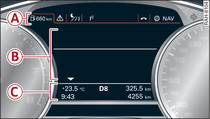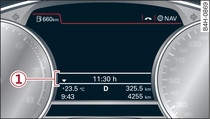|

- Fig. 1 Driver information system in instrument cluster

- Fig. 2 Instrument cluster: System status indicator (example)
The data -B- stored in the driver information system is presented in different display tabs -A- Fig. 1. The following information may be displayed, depending on the vehicle equipment:
| -A- |
-B- |
|---|---|
| 1st tab |
Vehicle functions: |
| On-board computer*
►Link | |
| Efficiency program*
►Link | |
| Digital speedometer | |
| Cruise control system*
►Link | |
| Adaptive cruise control* and braking guard*
►Link | |
| Active lane assist*
►Link | |
| Speed limit display*
►Link | |
| Reduced display | |
| 2nd tab |
Warning/indicator lamps and driver messages |
| Warning if one of the doors, bonnet or boot lid is not closed | |
| Service interval display
►Link | |
| Speed warning function*
►Link | |
| 3rd tab |
Night vision assist*
►Link |
| 4th tab |
Audio/video |
| 5th tab |
Telephone* |
| 6th tab |
Navigation* |
The second and third tabs are only visible if one or more warning/indicator lamps or driver messages is displayed or if the relevant system is switched on.
The status line -C- Fig. 1 appears at the bottom of the instrument cluster display. The outside temperature, time, selector lever position, trip recorder and overall mileage recorder are displayed here permanently.
Do not rely on the outside temperature display as an ice warning. Bear in mind that there may be patches of ice on the roads even at outside temperatures around +5 ℃ – risk of accident!
Note
- You can change the measurement units for temperature or speed, etc. via the infotainment system.
- When the vehicle is stationary or travelling at very low speeds, the temperature displayed may be slightly higher than the actual outside temperature as a result of the heat radiated from the engine.
- For information on how to operate the audio/video and navigation* functions, please refer to the separate Operating Manual for your infotainment system.
